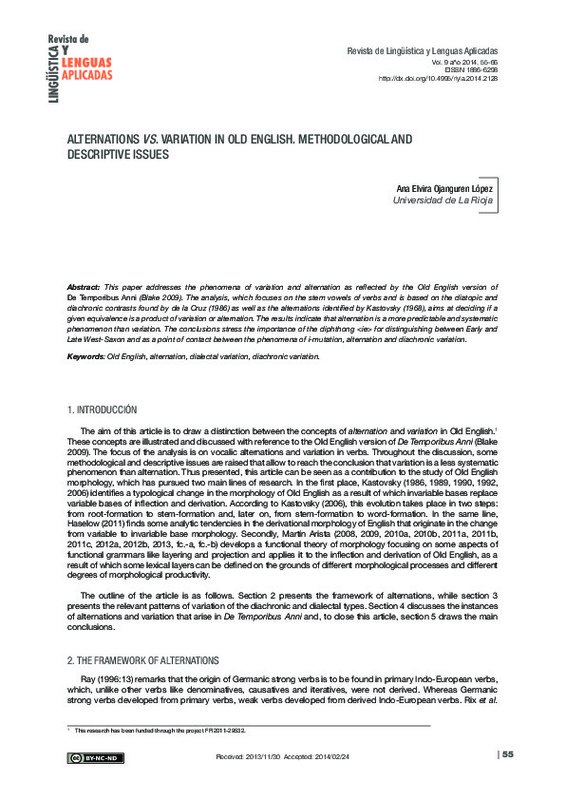JavaScript is disabled for your browser. Some features of this site may not work without it.
Buscar en RiuNet
Listar
Mi cuenta
Estadísticas
Ayuda RiuNet
Admin. UPV
Alternation vs. variation in Old English
Mostrar el registro sencillo del ítem
Ficheros en el ítem
| dc.contributor.author | Ojanguren López, Ana Elvira
|
es_ES |
| dc.date.accessioned | 2014-11-26T10:25:13Z | |
| dc.date.available | 2014-11-26T10:25:13Z | |
| dc.date.issued | 2014-07-01 | |
| dc.identifier.issn | 1886-2438 | |
| dc.identifier.uri | http://hdl.handle.net/10251/44861 | |
| dc.description.abstract | [EN] This paper addresses the phenomena of variation and alternation as reflected by the Old English version of De Temporibus Anni (Blake 2009).The analysis, which focuses on the stem vowels of verbs and is based on the diatopic and diachronic contrasts found by de la Cruz (1986) as well as the alternations identified by Kastovsky (1968), aims at deciding if a given equivalence is a product of variation or alternation. The results obtained reveal that alternation is a more predictable and systematic phenomenon than variation. The conclusions stress the importance of the diphthong /ie/ for discerning between Early and Late West-Saxon and as a point of contact between the phenomena of i-mutation, alternation and diachronic variation. | es_ES |
| dc.description.sponsorship | This research has been funded through the project FFI2011-29532. | |
| dc.language | Inglés | es_ES |
| dc.publisher | Editorial Universitat Politècnica de València | |
| dc.relation.ispartof | Revista de Lingüística y Lenguas Aplicadas | |
| dc.rights | Reserva de todos los derechos | es_ES |
| dc.subject | Old English | es_ES |
| dc.subject | Alternation | es_ES |
| dc.subject | Dialectal variation | es_ES |
| dc.subject | Diachronic variation | es_ES |
| dc.title | Alternation vs. variation in Old English | es_ES |
| dc.type | Artículo | es_ES |
| dc.date.updated | 2014-11-26T08:32:47Z | |
| dc.identifier.doi | 10.4995/rlyla.2014.2128 | |
| dc.relation.projectID | info:eu-repo/grantAgreement/MICINN//FFI2011-29532/ES/POLOS SEMANTICOS EN EL LEXICO DEL INGLES ANTIGUO. CONSTRUCCION DEL SIGNIFICADO, PRIMITIVOS SEMANTICOS Y FORMACION DE PALABRAS/ | |
| dc.rights.accessRights | Abierto | es_ES |
| dc.description.bibliographicCitation | Ojanguren López, AE. (2014). Alternation vs. variation in Old English. Revista de Lingüística y Lenguas Aplicadas. 9:55-66. https://doi.org/10.4995/rlyla.2014.2128 | es_ES |
| dc.description.accrualMethod | SWORD | es_ES |
| dc.relation.publisherversion | https://doi.org/10.4995/rlyla.2014.2128 | es_ES |
| dc.description.upvformatpinicio | 55 | es_ES |
| dc.description.upvformatpfin | 66 | es_ES |
| dc.type.version | info:eu-repo/semantics/publishedVersion | es_ES |
| dc.description.volume | 9 | |
| dc.identifier.eissn | 1886-6298 | |
| dc.contributor.funder | Ministerio de Ciencia e Innovación | |
| dc.description.references | Bammesberger, A. (1965). Deverbative jan-Verba des Altenglischen, vergleichend mit den übrigen altgermanischen Sprachen dargestellt. München: Ludwig-Maximilians Universität. | es_ES |
| dc.description.references | Blake, M. (2009). Ælfric's de Temporibus Anni. Cambridge: D. S. Brewer. | es_ES |
| dc.description.references | Hogg, R. M. and R. D. Fulk. (2011). A Grammar of Old English. Volume 2: Morphology. Oxford: Blackwell. | es_ES |
| dc.description.references | Kastovsky, D. (1986). "Deverbal nouns in Old and Modern English: from stem-formation to word-formation". In J. Fisiak (ed.), Historical Semantics-Historical Word Formation. Berlin: Mouton de Gruyter. pp. 221-261. | es_ES |
| dc.description.references | Kastovsky, D. (1989). "Morphophonemic alternations and the history of English: Examples from Old English". In Manfred Markus (ed.), Historical English. On the occasion of Karl Brunner's 100th birthday. Innsbruck: Universität. pp. 112-123. | es_ES |
| dc.description.references | Lass, R. and J. Anderson. (1975). Old English Phonology. Cambridge: Cambridge University Press | es_ES |
| dc.description.references | Martín Arista, J. (2010a). "OE strong verbs derived from strong verbs". SKASE Journal of Theoretical Linguistics, 7: 36-56. | es_ES |
| dc.description.references | Martín Arista, J. (2011a). "Morphological relatedness and zero alternation in Old English". In P. Guerrero Medina (ed.) Morphosyntactic Alternations in English. Functional and Cognitive Perspectives. Sheffield: Equinox. pp. 339-362. | es_ES |
| dc.description.references | Martín Arista, J. (2011c). "Projections and constructions in functional morphology: the case of HRĒOW". Language and Linguistics 12/2: 393-425. | es_ES |
| dc.description.references | Martín Arista, J. (2012b). "Morfología flexiva en RRG". In R. Mairal, L. Guerrero and C. González (eds.), El funcionalismo en la teoría lingüística. Madrid: Akal Universitaria. pp. 43-58. | es_ES |
| dc.description.references | Palmgren, C. (1904). English Gradation-Nouns in Their Relation to Strong Verbs. Uppsala: University of Uppsala. | es_ES |
| dc.description.references | Ray, B. K. (1996). Old English Morphology and Indo-European. Delhi: Sharada Publishing House. | es_ES |
| dc.description.references | Rix, H., M. Kümmel, T. Zenhder, R. Lipp and B. Schirmer. (2001). Lexicon der indogermanischen Verben. Wiesbaden: Ludwig Reichert Verlag. | es_ES |
| dc.description.references | Schön, E. (1905). Die Bildung des Adjectivs im Altenglischen. Kiel: Verlag von Robert Cordes. | es_ES |
| dc.description.references | Schuldt, C. (1905). Die Bildung der schwachen Verba im Altenglischen. Kiel: Verlag von Robert Cordes. | es_ES |
| dc.description.references | Szemerényi, O. (1996). Introduction to Indo-European Linguistics. Oxford: Oxford University Press. | es_ES |








